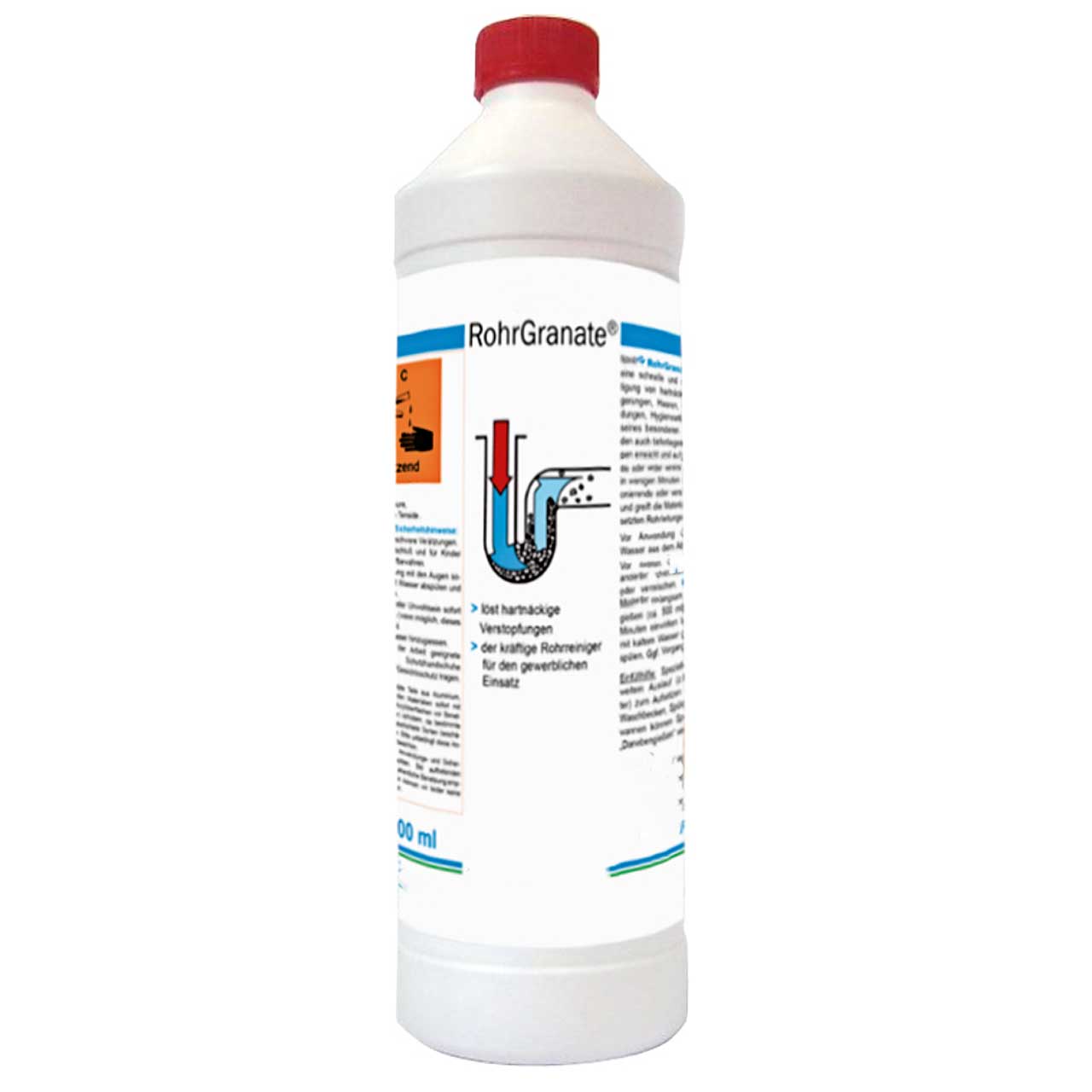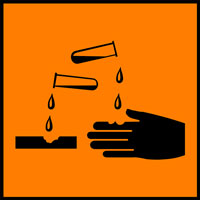- A
- B
- C
- D
- Determine the right diameter of a drain cleaning cable
- Differences of rak and ROWO / ROTHENBERGER drain cleaning machines
- Drain cleaners - Application and operation
- Drain cleaning cable & co. - terms and intended use
- Drain cleaning cable or chemical pipe cleaner?
- Drain cleaning cable: function and correct application
- Drain cleaning device or drain cleaning cable - which is better?
- Drain clogged: how to remove a drain blockage in the siphon
- Drain stinks - what to do?
- E
- F
- G
- H
- I
- J
- K
- L
- M
- N
- O
- P
- Q
- R
- S
- T
- U
- V
- W
- X
- Y
- Z
- #
Drain cleaners - Application and operation
What to do in case of contact with chemical pipe cleaners? - The most important things first!
Rinse with water immediately! Diluting the caustic lye is the quickest way to prevent damage to the tissue! Affected skin areas and eyes must be rinsed intensively immediately, at least 15 minutes! Also remove all clothing where the caustic solution may still be present. At the same time it is best to call 112 or a doctor! Please point out that this is a chemical burn caused by chemical drain cleaner or a strong lye!
What is chemical drain drain cleaner and how does it work?

Chemical drain cleaners are liquids, gels or granulates that cause a chemical reaction when they come into contact with (waste) water in the pipe. The aim of this reaction is to remove the cause of the drain blockage by dissolving or binding it. This can work very well if the drain blockage is caused by organic material: The chemical reaction is precisely designed to attack fats, cells (and thus also hair), oils, cellulose (paper). Usually the structure of the clogged material is destroyed, so that the drain cleaner literally "dissolves" the drain blockage. The chemical reaction requires a certain time for this, which is why a specified exposure time should be observed. However, since the reaction should be stopped after the blockage has been removed, the drain cleaner must not remain in the pipe beyond the recommended time. Otherwise undesirable chemical processes could occur between the cleaner and the material of the pipe. Never exceed the recommended dose! If the lye cannot remove the drain blockage, this is usually due to the fact that it is caused by a substance or foreign body, because the lye cannot dissolve. "A lot helps a lot" has the opposite effect here: the blockage is not removed, but on the contrary, the drain cleaner can crystallize out and lead to a massive complete blockage of the pipe! By finally flushing the pipe vigorously with water, it is ensured that the substances which react with each other are removed from the sewage pipe. The "household remedies" for drain cleaning - sodium bicarbonate, baking powder, soda - are very weak alkaline solutions and, strictly speaking, also belong to the group of chemical pipe cleaners.
Big disadvantage: granular pipe cleaner crystallizes out of
Granular cleaners contain alkaline components as well as aluminium granules, nitrate and sodium carbonate. If water is added, a strong lye is formed. The aluminium reacts with the lye under heat development and the formation of hydrogen. The released hydrogen, in combination with oxygen, becomes a highly explosive oxyhydrogen gas. To prevent this, the hydrogen is combined with the nitrate to form ammonia. This can cause the typical acrid smell. It is therefore essential that the premises are well ventilated! If the granulate is overdosed, the heat generated can cause damage to plastic drainage pipes. The drain cleaner can crystallize and seal the pipe.
If the chemical drain cleaner is introduced into the drain and is not able to remove the drain blockage, this is the "worst case scenario"! This is because the highly corrosive lye cannot drain into the sewerage system as intended. This scenario is anything but unlikely, because drain blockages can also be caused by foreign objects such as metal (jewellery and other objects that have fallen into the drain unintentionally or unnoticed. Chemical drain cleaner will not help here.
IMPORTANT: If blocked by drain cleaner, DO NOT under any circumstances try to remove it with a plunger, a pipe cleaning spiral or similar! There is a risk that you will come into contact with the highly corrosive lye and suffer severe burns!
Wear protective goggles, chemical protection gloves and protective clothing. If you use liquid drain cleaner, you can carefully, gradually, pour diluted acetic or citric acid into the drain. As described in the section on how it works, the caustic and acid neutralize each other and form water. As the chemical reaction is very violent, this should only be done very carefully, slowly and gradually over a longer period of time.
If your pipe is blocked by crystallised granulate drain cleaner, pour boiling water into the pipe bit by bit. It takes time, but the crystalline structure is broken down by the hot water over time.
How does the chemical reaction of drain cleaners work?
The chemical drain cleaner consists of a strongly alkaline substance, usually sodium hydroxide (NaOH) or potassium hydroxide (KOH), which in combination with (waste) water forms a strong lye or base. Depending on the substance used, a caustic soda solution or a potassium hydroxide solution is thus formed. Both have a high pH value. The chemical reaction between sodium hydroxide (pipe cleaner) and water to produce the lye, which usually happens invisibly "in the pipe" in the case of the drain cleaner, is associated with the release of energy in the form of heat. The lye heats up and in extreme cases can also bring the water involved in the reaction to the boil. The resulting steam can lead to the build-up of pressure, if it cannot escape.

IMPORTANT: When using chemical pipe cleaners, always wear suitable protective clothing, chemical protection gloves (e.g. made of butyl) and protective goggles! If there is an unforeseen chemical reaction outside the pipe, the lightning-like boiling of the water can cause unforeseen splashes of the caustic lye!
Hydroxide ions (OH-) are formed as a result of the reaction. Just like an acid, this hydroxide dissolved in water is highly corrosive: if it hits organic tissue, the molecular cell structures are broken up, which means that the cell is destroyed. For organic materials in the pipe, such as hair, scales, faeces, food waste and paper, this means that they dissolve. If the lye meets oil or fat, which are the cause of many drain blockages in the kitchen area, it converts them into glycerine or soap. In contrast to oil or grease, glycerine and soap are water-soluble, so that they can then simply be rinsed out of the pipe.
IMPORTANT: When the hydroxide ions of a base meet their chemical counterpart, the H3O ions of an acid, they react with them to form water (H2O) and a salt. The alkali and the acid neutralize each other. The resulting chemical reaction takes place with the release of a lot of energy, so it can also cause the water that is formed or surrounding water to boil, so that the caustic acid and lye splash! Therefore, under no circumstances should an acid or acidic cleaning agent be used in combination with a chemical pipe cleaner! ATTENTION: Many bathroom cleaners and toilet cleaners that dissolve lime work on an acid basis! These must therefore under no circumstances be used in the drain until the lye has been completely removed!
Is chemical drain cleaner dangerous and harmful to the environment?
Since the effect of chemical drain cleaner is based on the formation of a strongly corrosive lye, this question can only be answered with YES! If the lye comes into contact with the skin, it immediately begins to destroy the cell structure of the skin. The result is severe skin damage. Unintentional splashes of the lye in contact with the eyes cause severe damage to the cornea and the eye. The lye burns itself into the skin due to the resulting heat, causing severe pain. This can lead to irreparable damage to the deeper layers of the skin "down to the bone". The upper layers of the skin are directly affected, redness and blistering occur. The reaction must be stopped as quickly as possible by dilution with water! Chemical drain cleaner are among the most dangerous substances for the health of people in the household! Therefore, always make sure that they are handled properly and store drain cleaner in a safe place. Chemical drain cleaner are absolutely taboo for children!
The consequences of the improper use of chemical pipe cleaners are described in this article", where the excessive use of sulphuric acid-based drain cleaner resulted in the escape of corrosive vapours.
In combination with water, the drain cleaner forms a highly corrosive lye, the aim of which is to break down and destroy organic compounds. If the lye is released from the pipe into the environment, it destroys living organic tissue. Plants are destroyed, micro-organisms are killed - when they come into contact with animals (rats, insects, etc.) they suffer the most severe burns, which often lead to death. Of course, the lye is strongly diluted on its journey through the sewerage system. But e.g. at the transition of the house drain into the street canal the mixture is often still undiluted. So consider for yourself whether you want to use chemical drain cleaner in addition to the danger to yourself despite this potential environmental damage.
The alternative to chemical pipe cleaners: pipe cleaning spiral, high-pressure pump or biological drain cleaner
The safe and environmentally friendly alternative to chemical pipe cleaners is to use a pipe cleaning spiral. Here, the drain cleaning is not chemical but mechanical: The blockage is loosened by the spring steel wire of the drain cable in the pipe and then rinsed out. There is no risk of burns or damage to health. The working principle of the drain cable is illustrated in our following video:
You can find more information on this in our guide article . You can also use a without any concerns. Its principle of operation is based on the solution of drain blockage by water pressure or air pressure, and is therefore completely harmless.
IMPORTANT: Never use a pipe cleaning spiral or high pressure flushing if you have previously tipped chemical drain cleaner into the drain! There is a risk of burns from contact of the drain cable with the cleaner and then with the skin and eyes! If you call a professional drain cleaner or other persons for help, it is essential to inform them that a chemical drain cleaner has already been used and is still standing in the pipe, either completely or diluted!
Another alternative is the biological drain cleaner. These consist of enzymes and / or bacteria that naturally decompose organic materials. This is much gentler and, in contrast to chemical drain cleaner, completely environmentally friendly. The disadvantage, however, is the comparatively long exposure time. In addition, the biological or enzymatic drain cleaner is no help if inorganic foreign bodies clog the pipe. By the way, the household remedy cola for drain cleaning also belongs to the category of biological drain cleaners!


